Crash Story File: The Sources of the Trinity Tale

By Douglas Dean Johnson
@ddeanjohnson on Twitter
Original publication: May 1, 2023. All substantive changes and updates to this article after that date are listed in a log that appears at the bottom of the article.
You are in the Crash Story Files, a series of investigative reports examining claims that a UFO crashed and was recovered near San Antonio, New Mexico, in August 1945. To go back to the Crash Story hub story and index, click here.
“And we have the testimony of the two boys.” – Paola Harris, MUFON UFO Journal, June 2016, p. 12.
"Besides, they were little kids. They couldn't make this up....I can tell you as a journalist, it's a very consistent story." – Jaime Maussen, ufologist, August 27, 2016
In a 2013 lecture, Paola Harris said that when she first read the story of the crash of a UFO and its recovery by the military near San Antonio, New Mexico, in August 1945, she said to herself, “I mean, these two little kids, I'm sure they didn't make it up. I mean, one is 6 and one is 9.” Harris has made many similar remarks in other places – how can you think that two young boys made up such an elaborate tale?
However, Harris’ logic is strikingly defective, because there is no record whatever from those two boys of long ago relating to the UFO tale. What we have instead is a story first heard from the mouths of two men, Remigio (Reme) Baca, and Joseph Lopez “Jose” Padilla, who were ages 65 and 66 when they first presented the tale to “the world.”
Remigio (Reme) Baca was born on October 26, 1938, in San Antonio, New Mexico (Socorro County), and died on June 12, 2013, in Takoma, Washington. Padilla was born on November 24, 1936, also in or near San Antonio. Padilla is still alive--86 years old at this writing.
Padilla left school at age 13 for reasons that are murky. He told a newspaper writer that he had joined the New Mexico National Guard at age 13 in a time when this was allowed due to losses during World War II – a claim both implausible and false, as I address elsewhere. Padilla also has said that he moved to California initially in 1951, then long-term in 1955. Padilla told Vallee and Harris stories about his past that the authors have touted as enhancing Padilla’s credibility, but those credibility-enhancing tales were also inventions, as I document in other Crash Story Files.
Baca moved to Tacoma, Washington in 1955, after his first year of high school. He later substantially misrepresented important aspects of his history there, on matters that Vallee and Harris believed and cited as evidences of Baca’s credibility and the validity of his story. I address those misrepresentations and their significance here and here.
Ostensibly the two men exchanged mail for awhile, then had no contact until either 2002 or 2003 (versions vary).
NO CONTEMPORARY RECORDS
No one has yet produced any record created prior to 2003 in which any person recorded that Baca or Padilla had told them of a purported August 1945 UFO crash near San Antonio, New Mexico.
Ron Brinkley, a now-deceased New Mexico resident who first got Jacques Vallee interested in the case, told Vallee, “Nobody spoke about it for many years.” (Trinity: The Best-Kept Secret, Second Edition, page xi) In my judgment, the reason that “nobody spoke about it for many years” is because no real events had occurred for local people to remember or speak about. “Nobody spoke about it”-- because the fabricated tale had not yet been published by an indulgent Ben Moffett, in the Socorro County Mountain Mail in the late October and early November editions of 2003.
No such pre-2003 contemporary record, describing any element of a UFO crash-recovery in 1945, is found in the Vallee-Harris book, or any other of the voluminous Trinity-promoting materials that I have reviewed. No old newspaper items about mysterious military activity, no old diary entries or letters to family members. I have seen no pre-2003 document to indicate that a narrative of a 1945 crash and recovery, witnessed by two boys or anybody else, existed as such until 2003.
A transcript of an undated conversation with Paola Harris, probably conducted in 2010, is included in Baca’s 2011 book Born on the Edge of Ground Zero. Baca’s wife Victoria said that Reme would sometimes speak about UFOs but she didn’t believe in extraterrestrials and did not want to hear about it, until they experienced a joint UFO sighting in July 1994, which caused her to become a believer in extraterrestrial visitation. She said that after that, she accepted as well Reme’s account of a childhood experience (but regarding that experience, he had previously not provided details, she said).
As for Jose Padilla, Richard Syrett asked him directly (in December 2010) whether he had ever even mentioned the crash even to his wife or other family members, prior to 2003.
SYRETT: Did you ever mention it to them?
PADILLA: No, not until 2003, when we got discovered, when my wife heard about it.
Although there is no record of the purported August 1945 UFO crash and recovery that pre-dates the first publication of the Baca-Padilla story in October 2003, Paola Harris sometimes says things that seem intended to lead the unwary to believe otherwise.
For example, in what Harris called her debut public presentation on the case, on Coast-to-Coast AM with George Noory on December 1, 2010, Noory invited Harris to “set the stage” for later call-ins by Baca and Padilla. Harris responded:
Well, I think who set the stage very appropriately was Ben Moffitt, who was a journalist for the Mountain Mail, Socorro, New Mexico, who wrote the story in 2003. And he said that a small contingent of U.S. Army passed through almost unnoticed through San Antonio in mid-to-late August [1945] on a secret assignment. And this secret assignment had to do with the shattered remains of a flying apparatus on a flatbed truck. And that the operation took about three days, and that the two former San Antonions, Reme Baca and Jose Padilla, were eyewitness to an event.
By that statement, Harris seemingly intended the listener to believe that a local journalist, Ben Moffett, was describing local military activity in August, 1945, of which the journalist had some independent knowledge—perhaps, the memories of some local elders who remembered it, or some source other than Baca and Padilla.
But we know now that was not the case, because Moffett himself in 2015 made it explicitly clear that he had merely recited the events as described to him by Baca and Padilla—and moreover, that he personally “was never comfortable with many of Baca’s assertions...” Moffett wrote:
The newspaper story appeared in the Halloween issue (I stress Halloween) in 2003, and while it was written in a serious tone, I was never comfortable with many of Baca's assertions that went into his book.... Soon thereafter, Baca began giving speeches to UFO groups and made talk radio appearances. My story in the Mountain Mail reflects what Remigio Baca told me, and I used no other sources except his co-author, Jose Padilla, both of whom claimed to have seen a crashed UFO. My contribution to the story I wrote for the newspaper was limited to information I received from Baca and Padilla and my own knowledge of the geography, culture and natural history of the general area. [boldface added for emphasis].
“Natural history” refers, of course, to knowledge of the local terrain and fauna, not of historical events.
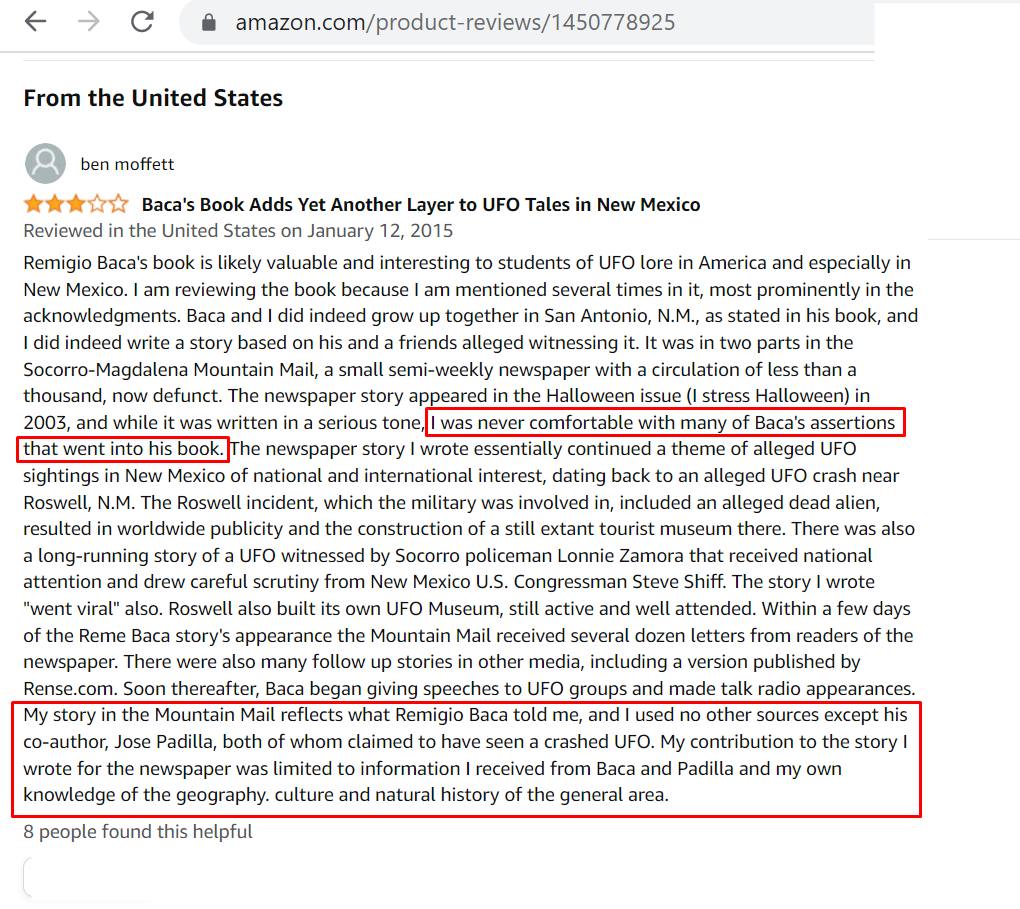
Harris misconstrued or misrepresented Moffett's words in the same way in a press release or mini-article that she put out in on November 29, 2010, to promote the case and the forthcoming publication of the Baca-Padilla book Born on the Edge of Ground Zero.
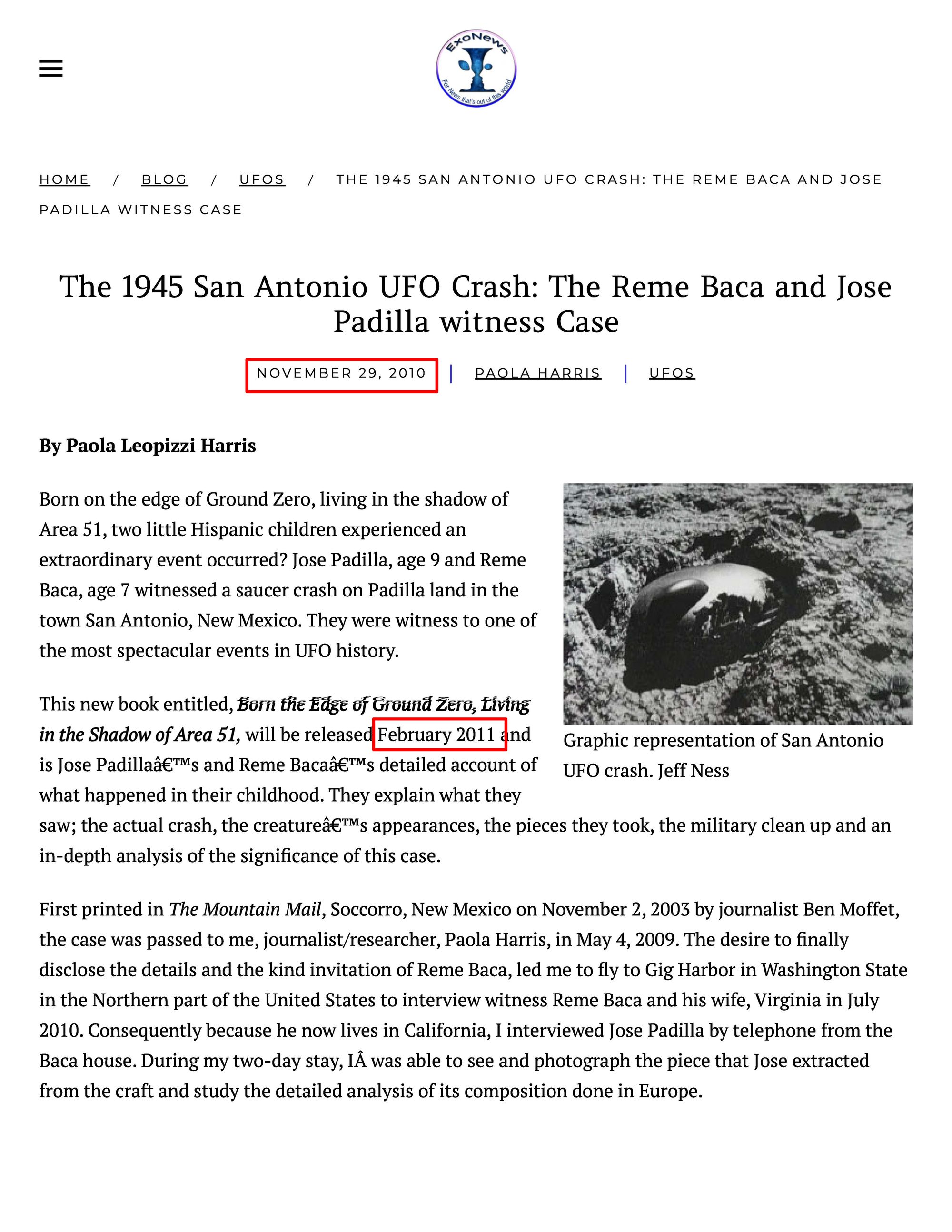
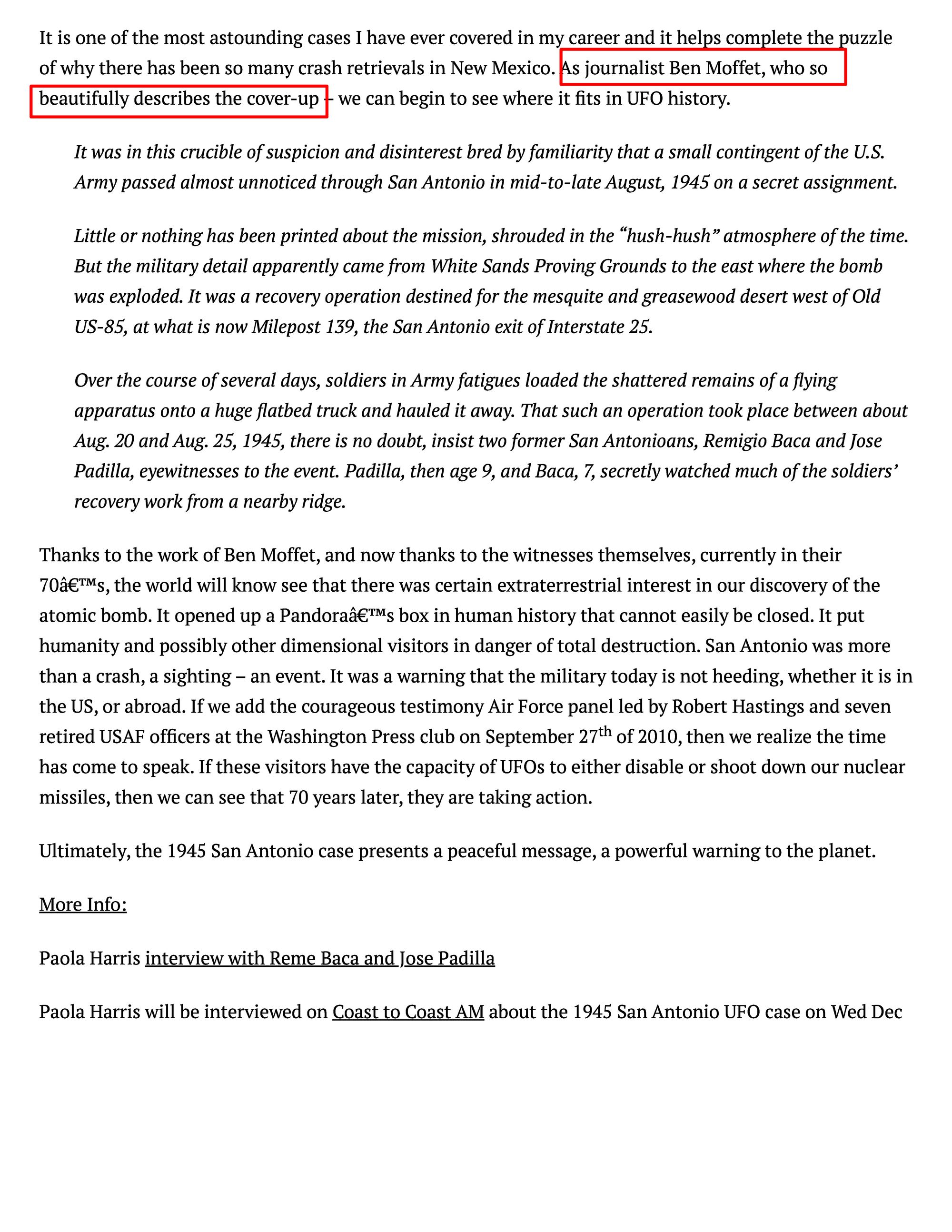
REME BACA'S PURPORTED STATEMENTS TO HIS WIFE, VIRGINIA
In his 2011 book, Baca attributed to his wife Virginia statements that he spoke of his “childhood experience.”
“My husband Reme mentioned his discovery of an object in the New Mexico Desert as a child,” Virginia says. “At that time, there was no place for me to fit it into my life or my mind. I rejected it, didn’t even want to discuss it.” (p. 68)
However, no dates are presented for any of this, nor details, nor any contemporary record of such purported conversations.
Elsewhere in the book (pp. 139-150). Baca reproduced the transcript of a conversation among Paola Harris, Virginia Baca, and Reme Baca., apparently conducted sometime in 2010. While at times Harris seems to be interviewing herself, Virginia does agree that she never heard about the purported childhood experience in detail. What follows appears on pages 144-145.
HARRIS: So when you first heard about Reme’s story when he was very young, did you just feel that it was again religion to talk about it?
VIRGINIA BACA: No. I just didn’t believe. Period. No. I didn’t believe in UFOs.
HARRIS: Then you thought he might have found an airplane or something?
VIRGINIA BACA: You know, he never went into it.
HARRIS: Okay. So now that you’re here, because he does go into it in great detail now, so he just didn’t talk to you about it in great detail.
VIRGINIA BACA: No.
HARRIS [to Reme]: And you didn’t talk to her about it because you thought you’d scare her?
REME BACA: No.
VIRGINIA BACA: No, I didn’t believe it. I mean, he talked to me about a UFO like that time, I said...
HARRIS: But he never lied. He doesn’t lie.
VIRGINIA BACA: I know that, but I...
Again, this interview is not a pre-2003 contemporary record—it was apparently recorded in 2010.
REME BACA IN THE UFO WORLD IN THE 1990s
During the 1990s, Reme Baca was deeply into UFO culture as a member of MUFON in Ventura County, California.
While I found no contemporary record of anyone talking about the 1945 crash story until 2003, Donald R. Schmitt has reported that Reme Baca was peddling, in 1995, a story about being involved in a UFO crash in New Mexico in 1947. Schmitt once served as Director of Special Investigations for J. Allen Hynek Center for UFO Studies for ten years, and has authored or co-authored numerous books on Roswell and other UFO-related matters.
In a copyrighted essay published in 2021, titled “The Passport to Magonia Ends at Trinity,” Schmitt wrote:
It was in the late summer of 1997 [but see correction below, placing the conversation in 1995] that I had just completed a Roswell presentation in Ventura, California, just north of Los Angeles. I was introduced to a man who described that he was witness to the crash in 1947 but added that it was on “The Plains,” which I assumed to be the Plains of San Agustin... I did take down his name [Reme Baca] and contact information and stored it in my witness-lead folder....It was abundantly clear that he became immersed in the subject, read books about the Roswell Incident, and attended my lecture on the subject when we were introduced. He even had me sign a copy of a Roswell book.
[UPDATE: On May 22, 2023, Donald Schmitt told me in an email that he had reviewed records related to lectures he gave in Ventura County in 1995, 1996, and 1997, and that he now believes his conversation with Baca occurred following a summer, 1995 lecture. The Baca family moved to Ventura County from Washington State in July, 1995.]
Even if Baca was peddling some version of the story in 1995 – and here again, we are dealing with a recollection of a conversation, not a contemporary document – the final form of the story probably could not have been constructed until Baca and Padilla reconnected in or about 2002, because Padilla became a major character in the tale.
[UPDATE: This article was written before I discovered a 30-minute recording of Reme Baca describing an entirely different boyhood UFO-crash adventure that he claimed he and Jose Padilla shared. The recording, made by UFO researcher-author Tom Carey less than a year before the first publication of the tale told in the Vallee-Harris book, told of encountering a downed alien craft in 1946 (not 1945), and differed in every other significant aspect from the later public story, other than the identity of the protagonists and the general geographical region. This discovery– absolutely fatal to the entire Trinity-crash edifice– is described in my article Crash Story File: The Reme Baca Smoking Gun Interview (May 20, 2023), which includes the entire unedited 30-minute audio file of Baca telling his original tale, which he later abandoned in favor of the new story that Harris and Vallee later swallowed whole.]
THE BACA-PADILLA STORY APPEARS (2003)
There are conflicting accounts of how Baca and Padilla reconnected, some involving Jose's son Sammy Padilla, and some not. In any event, after conferring by telephone and reaching agreement, Baca and Padilla took their story to Ben Moffett, who was a writer for a little newspaper called the Mountain Mail, published in Socorro County, with a circulation of about 1,000. Baca and Padilla had attended same grade school as Moffett, but the men had not been in touch since the early 1950s.
Moffett wrote a two-part story that recited the basic original version of the Baca-Padilla tale, which was published in the October 30 and November 6, 2003 editions of the Mountain Mail. Moffett also included a short section with biographical information that he received from Baca and Padilla. As already noted, in 2015 Moffett took pains to record that he had relied entirely on Baca and Padilla as sources of information for his story. Both the original stories and links to a re-publican by Jeff Rense that is earlier to read are found in the "Partial Listing of Sources" section of the Crash Story hub article.
LIMITED EXPOSURE
The original, bare-bones version of the Baca-Padilla story in the October 2003 Mountain Mail, and a couple of follow up radio interviews, reached only a limited audience.
A recording of the first radio appearance by Baca and Padilla, on the Jeff Rense Program, broadcast November 18, 2003, provides a useful baseline to illustrate how the story later grew, as I discuss in Crash Story File: The Shifting Narratives of the Trinity UFO Crash and Recovery.
Ryan S. Wood invited Baca to give a presentation at a November, 2005 “crash retrieval conference.” Baca accepted. Wood received a Word document (internally dated March, 2005) from Baca containing a narrative (much of it copied-and-pasted from the Moffett stories), and a Powerpoint presentation.
Baca cancelled at the last minute, on grounds his wife was ill, so Wood himself presented the account to the gathering in Las Vegas in November, 2005. An edited version of the Baca paper was published in 3rd Annual UFO Crash Retrieval Conference Proceedings (2005), of which I have a copy.
In addition, Ryan S. Wood devoted a short chapter to the case in his a 2005 book Majic Eyes Only.
On June 6-7, 2004, Timothy Good, author of many UFO-themed books, visited with Baca in Washington State. Good devoted less than a page to the case in his 2007 book Need to Know.
At least as early as 2005, Baca indicated that he would very soon be publishing his own book on the events of 1945, and he even specified the title: Born on the Edge of Ground Zero: Living in the Shadow of Area 51.
The second part of the title is quite odd, since nothing in the book has any obvious connection to Area 51, which is part of the Nellis Range in Nevada, about 600 miles west of San Antonio, New Mexico. Moreover, Area 51 did not exist in 1945. This appears to be yet another example of Baca’s proclivity for grabbing elements of other stories, and slapping them into his makeshift narratives, even when they fit poorly. Elsewhere in the Crash Story Files we examine other instances of Baca employing this technique that are of more consequence, involving real people rather than geographic sites.
Anyway, for reasons unknown to me, the little book (186 pages) was not actually self-published until June 8, 2011. Although Padilla was listed on the cover as a co-author of the book, it was copyrighted solely by Baca, and presented mostly in Baca’s voice (first-person singular).
Baca’s book incorporated long passages that Baca lifted verbatim from other peoples' works and dropped seamlessly into his text without acknowledgment (plagiarism), as I have illustrated elsewhere. The book also devotes many pages to transcripts of interviews by Paola Harris with Baca, Padilla, and Billy Brophy (about whom more below).
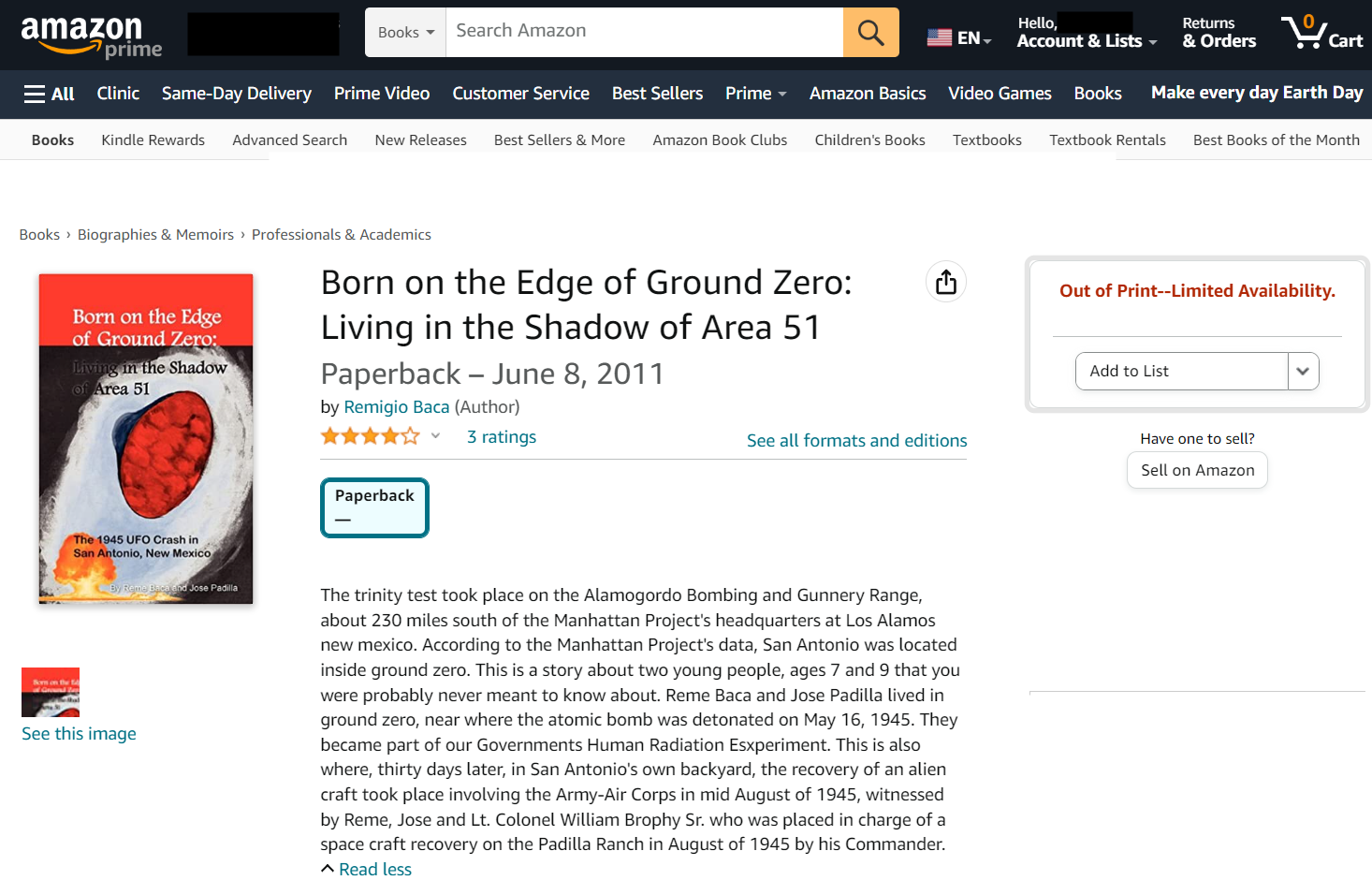
Although Born on the Edge of Ground Zero still has a page on Amazon.com (with several very interesting reviews, some cited in this article), it has long been out of print and is exceedingly hard to put one’s hands on. Fortunately, as I was preparing my initial series of articles on the Trinity crash hoax, a collaborator was able to locate a copy and photograph the pages for me. Later I was able to obtain the book itself.
In Trinity: The Best-Kept Secret (Second Edition, p. 337), Vallee and Harris listed Baca’s book at the very top of their list of sources. They wrote, “The primary reference to the events described here is monograph by Reme Baca and Jose Padilla, entitled: Born on the Edge of Ground Zero: Living in the Shadow of Area 51.”
That Baca is the primary author of the hoax story is further supported, in my opinion, by careful listening to multiple radio interviews, conducted as early as 2003 and as late as 2010, in which the two men called in simultaneously but from separate locations. Baca was voluble, reeling off detailed stories and anecdotes, sometimes having to be pulled back from rambling digressions. Padilla, in contrast, was usually relatively taciturn, often halting, giving short rote answers, sometimes frustrating the friendly interrogators with the minimalistic nature of his responses.
Padilla’s caution was probably prudent, because when he did become a little bolder and offered new elaborations of the rote accounts, he was prone to say things contradictory to previous statements or to things Reme had said. As I discuss in detail elsewhere, on December 10, 2010, when Padilla unexpectedly found himself all alone, responding to friendly but persistent questioner Mel Fabregas for nearly an hour, Padilla was soon at sea, contradicting the official narrative on multiple matters large and small. ((This is the encounter that I have dubbed Padilla’s Bungled Interview (PBI), from which I quote in several of the Crash Story Files.))
RAW MATERIALS
Certainly, whenever he constructed the UFO hoax tale, Baca had ample sources to draw on, even before Paola Harris came into his life and started loading him up with tales of Colonel Corso and other such material. [For additional information on possible sources on which Reme Baca drew, see my later article, Crash Story File: The Reme Baca Smoking-Gun Interview, published May 20, 2023, and the 30-minute audio recording of Baca being interviewed by Tom Carey circa late 2002 that is embedded in that article.]
THE ROSWELL CONNECTION: KEVIN RANDLE
In 1947, something unusual crashed at Corona, New Mexico, about 100 miles to the northeast (about 85 miles northwest of Roswell). The local news flap died down quickly after the Air Force explained that it had just been a “weather balloon.” But starting in the 1970s, many books have been published arguing for and against claims that an extraterrestrial craft or crafts crashed, and that exotic materials were recovered. Various of the story became and have remained an element of popular culture, and surely were known to Baca and likely to Padilla.
Kevin Randle, a retired military intelligence officer who has written many UFO-themed books, honed in on the derivative elements of the Baca-Padilla story in a lengthy critique of the First Edition of Trinity: The Best-Kept Secret.
Here’s one of the things to take away from this latest book. Both Baca and Padillo talk about many aspects of the UFO field. They talk about knowing people at the Foster ranch near Corona where Mack Brazel discovered a field of metallic debris. We have the family relation to Zamora which suggests more infusion of UFO material into the family lore. Then, we have many aspects of the Roswell case inserted into this new tale. The UFO crashed during a storm, as was suggested at Roswell. Lightning brought it down, as happened at Roswell, but I wonder that if a race can create interstellar craft, they would be able to avoid destruction by lightning. There was memory metal and even a discussion of fiber optics, just like Roswell.
The big thing that caught my attention was a description that suggested the aliens looked something like the Jerusalem Cricket… the very description supplied by Frankie Rowe when talking about the aliens at Roswell. There are just too many of the descriptions that are drawn from the Roswell case. To me, this suggests contamination rather than corroboration. It suggests that both men were well aware of the UFO field long before they began to talk of their childhood experiences. They had a better than average knowledge of what had been reported about UFOs and UFO crash/retrievals before they began talking about the UFO crash near San Antonio.
THE ROSWELL CONNECTION: DAVID HALPERIN
In his essay "Nuclear Test, UFO Crash – Vallee and Harris’s 'Trinity' (Part 2) (September 30, 2021), David Halperin wrote:
However long Baca and Padilla’s story may have gestated within them, it first surfaced in 2003–long after Roswell had become a household word. The two men had ample opportunity to saturate themselves with the testimonies of the Roswell witnesses. And in fact one of these witnesses, the doubtfully reliable Gerald Anderson, told in 1990 or thereabouts a story of his encounter (as a five-year-old boy) with a crashed UFO that sounds so close to Baca’s, even in its language, that it’s hard for me to believe Baca wasn’t drawing on it. “And all of a sudden it [the one surviving alien] just turned and looked straight at me between my uncle Ted and myself. And this is when–it was just like an explosion of things in my head, things… I just started, you know, feeling, just terrible depression and loneliness and fear and just, you know, awful, awful feelings that just suddenly burst into my mind there. I don’t know if that meant that it was communicating with me and I was the only one there that it could communicate with because I was a kid. I don’t know.” (Quoted by James McAndrew from the raw footage used for a 1993 video on Roswell.)
THE LONNIE ZAMORA SOCORRO INCIDENT
Moreover, on April 24, 1964, Lonnie Zamora, a policeman in Socorro, New Mexico—only about 11 miles north of Baca and Padilla’s childhood homes, encountered a egg-shaped craft and two diminutive occupants. The media-covered event was investigated by Dr. J. Allen Hynek, longtime civilian consultant to the U.S. Air Force’s Project Blue Book, and was influential in the evolution of Hynek’s thinking about UFO phenomena.
“Lonnie Zamora’s wife is Jose Padilla’s cousin, that’s an amazing coincidence,” observed Paola Harris in a conversation with Reme Baca, reproduced in Trinity: The Best-Kept Secret (Second Edition, p. 93). It seems likely, then, that Padilla was aware of the Zamora UFO incident even in the 1960s.
In his 2011 book, Baca referred to the 1964 Zamora incident, noting that he and Padilla had left the area years earlier, but “both of us kept up with Socorro County events...” (p. 34)
SOCORRO/ZAMORA AND THE CLAIMS OF RAY STANFORD
While it may be a bit of digression, I cannot entirely pass over another example of Jacques Vallee placing trust in people who don't deserve it: Vallee spends many pages in Trinity: The Best-Kept Secret reciting claims made by Ray Stanford relating to the Socorro case, including Stanford's tale of recovering metallic scrapings left by the landed UFO, which (in Stanford's telling) were subsequently tested by scientists associated with the Goddard Space Flight Center, declared non-terrestrial, and then stolen from Stanford-- all of this occurring in 1964 but narrated in a book self-published by Stanford in 1976, Socorro 'Saucer' in a Pentagon Pantry.
As a young fool (1974-1978), I was employed by the same nonprofit organization that employed Stanford, and in most respects was effectively run by Stanford. I associated with Stanford on a daily basis, and (to my later embarrassment) I provided free copy-editing services as Stanford wrote the Socorro book – wrote it mostly from "memory," including long purportedly verbatim quotations, often quite improbable. Stanford's account of the Goddard affair was forcefully and convincingly debunked by respected UFO researcher Richard Hall, who was directly involved in the entire series of 1964 events related to the metal debris.
Ray Stanford has a seven-decade history of making eye-popping claims related to UFO evidence and alien contacts (including 20 years as a trance-channeler of purported aliens) that have been abandoned by Stanford himself, convincingly discredited, and/or are entirely unsubstantiated. Indeed, not a single one of Stanford's innumerable earthshaking UFO-alien-evidence claims have ever been substantiated by truly independent and competent investigators. Moreover, Stanford in recent years has disseminated a grossly fictionalized account of a "UFO event" of December 10, 1975, for which I was personally present, causing me to publish contemporary records of the event (including a release approved by Stanford himself) discrediting the fictionalized Stanford account. See Section 6 of "Plasma Beam– or Fever Dream?," April 29, 2022.
WAS A UFO CRASH STORY POSTED BY “THE WANDERLING” ONE OF REME BACA’S SOURCES?
At least as early as 2012-2013, but perhaps earlier, an anonymous author who writes under the name “The Wanderling” posted two different essays on his website, https://the-wanderling.com, in which he purported to relate a UFO crash witnessed by “my uncle” in “mid-August 1945,” near San Antonio, Texas.
The second and far more detailed narrative is found in “Meeting Dr. La Paz. The 1945 UFO Crash and the Astronomer.” As this story goes, the uncle was engaged in botanical investigations in the desert, not far from San Antonio, New Mexico, when he witnessed a UFO crash. The crash itself is described in terms generally very similar to the Baca-Padilla account. Various improbable adventures ensue, including the uncle meeting and become friends with Dr. Lincoln La Paz.
[In real life, La Paz in 1945 was director of the Department of Mathematics and Astronomy at the University of New Mexico, founder and director (1945-1966)of the Institute of Meteoritics, and a consultant to the U.S. Air Force on certain UFO matters during that era.]
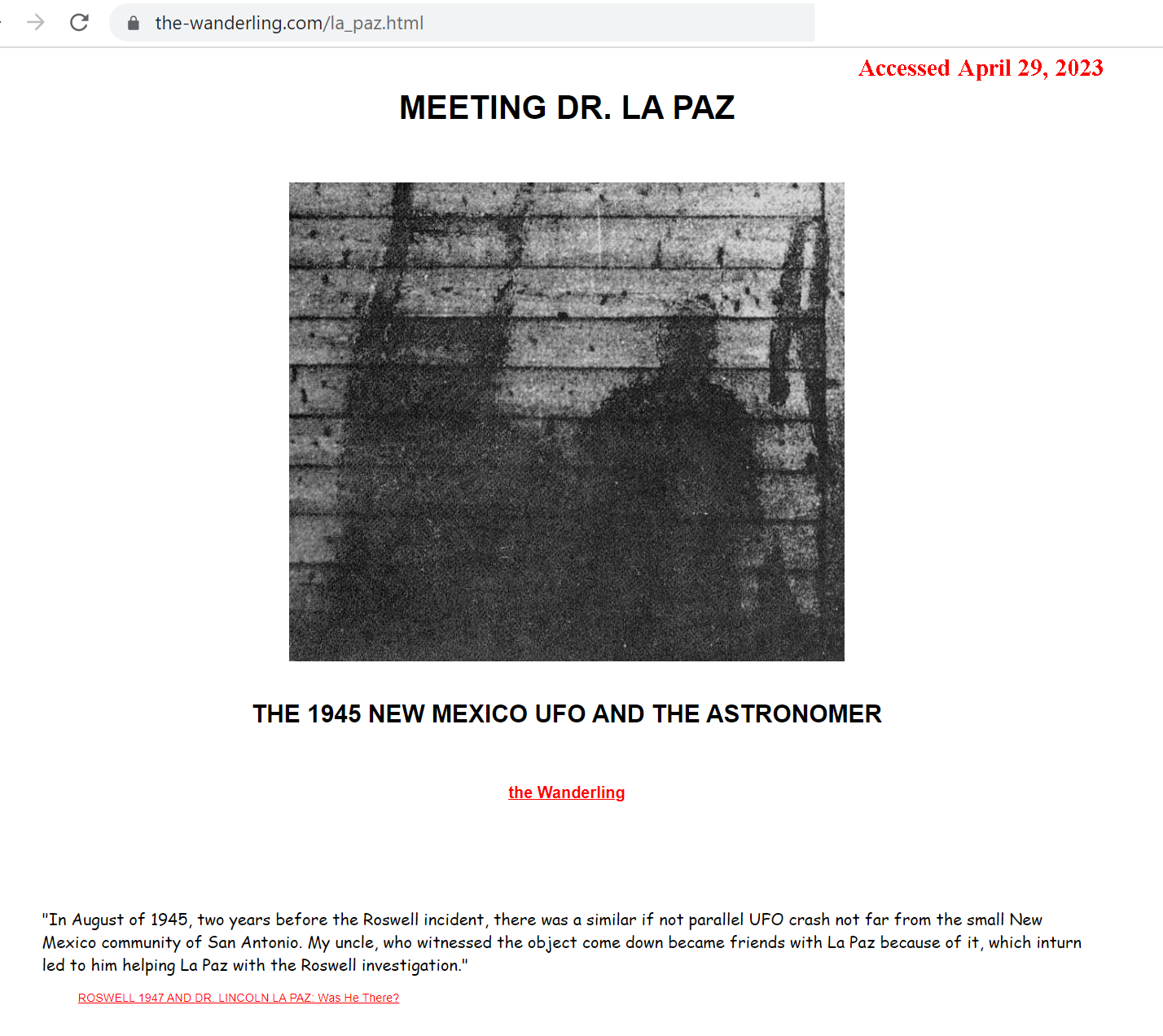
The Wanderling’s story certainly is in no sense even a hypothetical corroboration of the Baca-Padilla story, because it has an entirely different plot and an entirely different cast of characters—multiple witnesses, none of them little boys; no aliens seen dead or alive; and so forth. But among the common elements are the place, the approximate date (mid-August 1945), the description of the actual crash, and a general description of the mostly intact state of the crashed craft. The essay ends with a statement that the uncle died in 1989 without ever hearing about anyone else coming forth to talk about the 1945 event. The Wanderling narrative refers to the Baca-Padilla story not at all.
The detailed version of the Wanderling's story is found here. The Wayback Machine reveals that the earliest date at which that page was captured from the-wanderling.com was January 2, 2013. However, there are references on the website to material being migrated from earlier sites. If further investigation finds that Wanderling’s 1945 crash story was published prior to 2003, then it clearly would have been one of the sources from which Reme Baca lifted elements when he pieced together the tale that he and Padilla presented to Ben Moffett in 2003.
(An earlier essay on the Wanderling website, titled “Kensington Stone,” contains a much less detailed version of the 1945 UFO crash story. The Wayback machine says that the “Kensington Stone” page was first captured on May 25, 2012. The two iterations of the Wanderling’s crash story are consistent with each other, but the “Meeting Dr. La Paz” version goes into much more detail.)
A reader might object that it would have been quite risky or brazen for Reme Baca to lift major elements from a story that others might come across on the Internet, albeit on an obscure website that we would now call a blog. But remember, we are talking here about Reme Baca, the man who made still-living Eddie Apodaca a main character in his tale, even though anyone who checked could easily have learned that Apodaca was in Europe at the time and did not become a State Police officer until five years after the crash date; Reme Baca, a man who claimed to have been a close associate of Governor Dixy Lee Ray, even when there still many people living who would know that to be a laughable claim; Reme Baca, who lifted many pages of other people’s words verbatim and dropped them without attribution into his own published book. Again and again, Reme Baca counted on people not noticing, not checking, or not caring. His expectations in this regard were seldom disappointed.
However, it is also entirely possible that the author of the Wanderling tales wrote as late as 2012-2013 or not much earlier, and that the author was aware of the Baca-Padilla tale, but for some reason decided to write a different fictional short story based on what he recognized as a fictional premise. On balance, however, right now it seems to me a bit more likely that the Wanderling story came first; this is a matter that warrants further investigation.
WILLIAM J. BROPHY, THE “THIRD WITNESS”
Baca’s book introduced a third purported witness – William J. Brophy (1923-1986). In Baca’s book, William J. Brophy is a lieutenant colonel who was assigned to begin the recovery effort on the crashed spacecraft.
William J. Brophy was a real military pilot with a long and apparently distinguished service record, who died in 1986. There is not a shred of real evidence that this long-dead pilot ever said a word about involvement in any UFO crash. His youngest son, Sean Brophy, told me in a recorded January, 2023 interview that his father had once described an airborne encounter with a tubular UFO (this probably occurred in 1950), but never anything about involvement with crashed UFOs.
All of the claims about the supposed involvement of William J. Brophy in the 1945 UFO crash and recovery come from his eldest son, William Paul (“Billy”) Brophy. As I discuss in detail elsewhere, Billy Brophy is a UFO-crash enthusiast who, in various places, had previously associated his long-dead father with at least two other UFO crashes. Billy Brophy’s initial stories about his father’s involvement in the August 1945 events were “cleaned up” by Harris and Vallee for integration into their narrative. Subsequently, Billy’s account of his father’s role dramatically expanded. The latest version, which casts airman Brophy as an eyewitness flying over the just-crashed alien craft and seeing the two boys nearly, is in direct conflict with both the original Baca-Padilla accounts and with Billy Brophy’s original version.
In my opinion, there are substantial reasons to regard all of Billy Brophy’s morphing stories as the product of a disordered mind, entirely unworthy of credence. I explore Billy Brophy’s contributions in detail in Crash Story File: The Morphing Fantasies of “Billy” Brophy About His Airman Father. I zero in on the manner in which Vallee and Harris have engaged in major sub silentio edits of Brophy's testimony Crash Story File: The Suppressed Story of the Captured Alien.
BROPHY BRINGS IN PAOLA HARRIS
Billy Brophy brought the Baca-Padilla tale to the attention of Paola L. Harris, then in Italy, in 2009. In May 2009 Harris established telephone contact with Baca. On July 5, 2010 Harris interviewed Baca in person at his home near Tacoma, Washington. “In two days I realized that this man was telling the truth,” Harris said on The Syrett Conspiracy Show on December 12, 2010. Not much time to do a thorough independent investigation—or even a decent basic background check.
By December 1, 2010, Harris had both Baca and Padilla with her in a “debut” appearance on Coast-to-Coast AM with George Noory. Other radio interviews by Harris followed, sometimes joined by one or both “witnesses.”
By 2016 or earlier, Harris had enlisted Jan Harzan, then executive director of MUFON, in her promotion of the case. The promotion of the case by Harris in the MUFON UFO Journal and MUFON-sponsored conferences engendered considerable dissention within MUFON, including internal objections from the head of the MUFON Special Assignments Team (SAT), Chase Kloetzke, and by a member of the SAT, James C. Clarkson, who at that time was the MUFON State Director for Washington State. In a detailed email dated July 7, 2016, Clarkson expressed his negative assessments privately with a number of other UFO researchers. Both Clarkson and the initial recipient of his critique, Isaac Koi, have given me permission to reproduce that communication in total (with only one reference to a third party redacted).
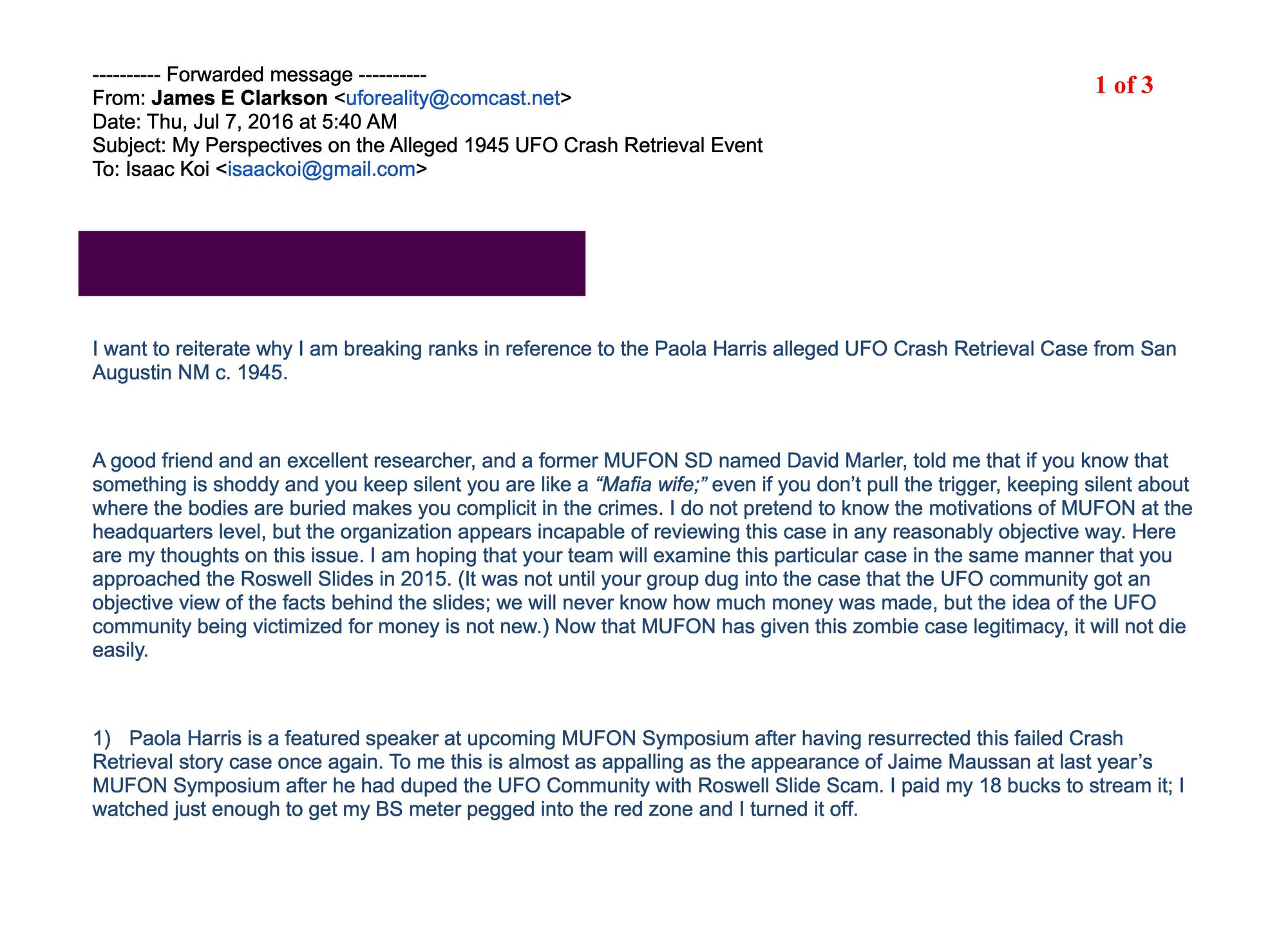
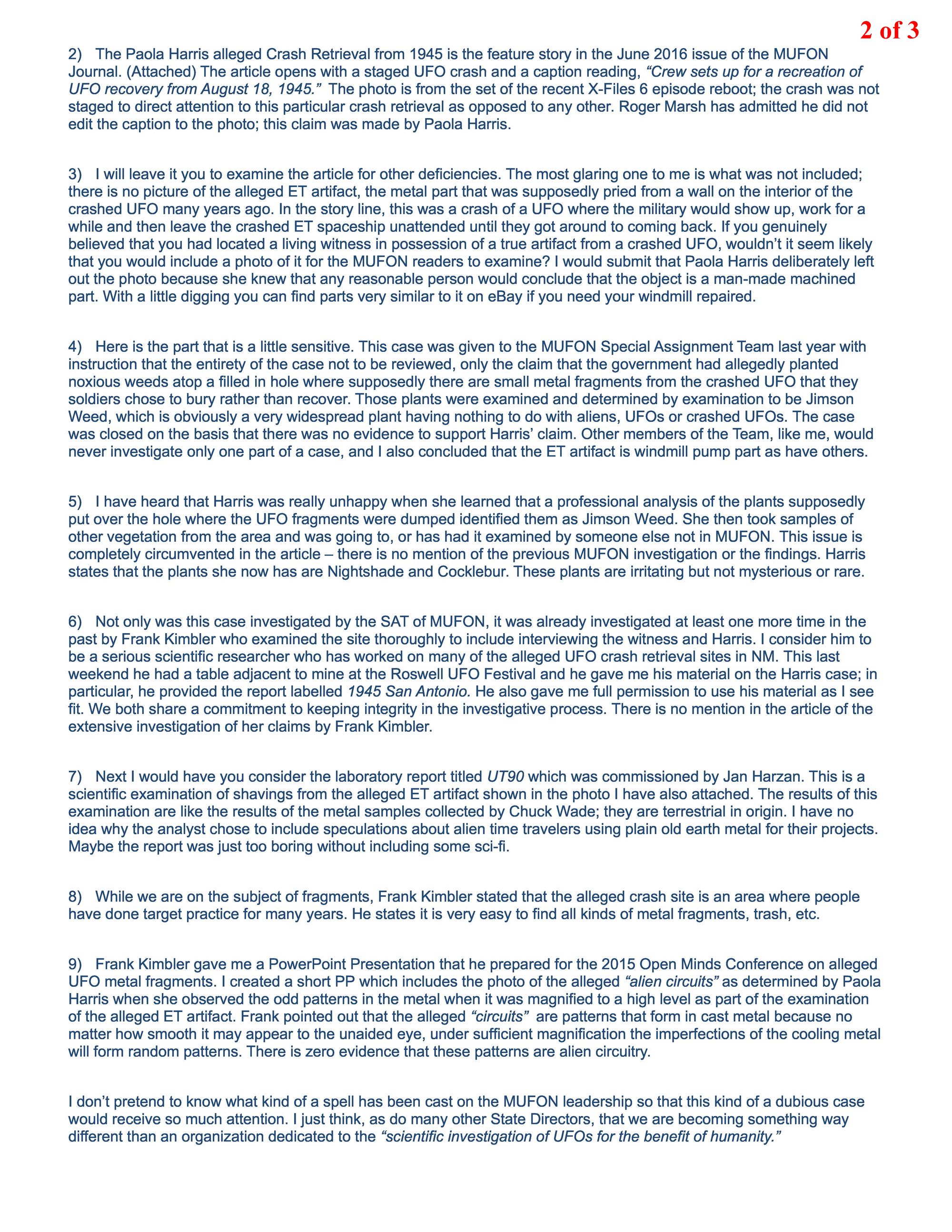

PAOLA HARRIS, CO-AUTHOR OF THE CURRENT VERISON OF THE 1945 TRINITY CRASH STORY
It is glaringly evident that the original 2003 Baca-Padilla story has been enhanced, expanded, and shaped in many ways, often unwittingly it seems, by the interventions of the case’s primary “investigator” and chief apostle, Paola L. Harris, who joined forces with Vallee in 2018.
I had paid no attention at all to Harris until I read the First Edition of Trinity: The Best-Kept Secret appeared in June 2021. I soon learned that she had long been widely regarded among serious-minded UFO investigators as a highly credulous and subjective individual, a tireless promoter many dubious alien-visitation stories, including stories widely recognized as hoaxes, such as the once-popular Billy Meier materials. I do not mean to suggest here that I think that all evidences of alien visitation are easily dismissible, but there is clearly no shortage of claims that are fabricated or generated by subjective interpretations of prosaic or ambiguous events.
The 2021 revelation of Vallee’s collaboration with Harris was received with various degrees of surprise and amazement among many serious-minded UFO researchers, some expressing their dismay publicly and others expressing it privately.
Harris also embraces even the most solidly debunked of the troves of fake “MJ-12” documents. For example, in the context of the Trinity case, she often brings up a truly ludicrous “Oppenheimer-Einstein memo,” dated June 1947, the virtually incoherent fever-dream contents of which would elicit mirth in any analyst with a modicum of discernment (e.g., “Another possibility may exist, that a species of homo sapiens might have established themselves as an independent nation on another celestrial body in our solar system and evolved culturally independent from ours”).
After my deep dive into recordings and transcripts of many Harris interviews and lectures about the Trinity case, she now impresses me as a woman who takes as her model the Queen in Alice in Wonderland, who “believes as many as six impossible things before breakfast.” Her wide-eyed credulity with respect to UFO-crash stories is exceeded only by her enthusiasm in promoting them, and her impatience with those who dispute them. I encourage readers to explore Paola Harris’s website if they wish to conduct a further examination of the general tenor of her work in "exopolitics" and as an "investigative journalist."
Both Reme Baca’s 2011 book and Trinity: The Best-Kept Secret contain lengthy transcripts of Harris “interviewing” Baca, Baca’s wife, Padilla, William P. (Billy) Brophy, and various other people. To say that Harris “leads the witnesses” would be to greatly understate the reality. If an interviewee faltered, Harris often suggested answers, interjected information from other stories known to her, smoothed over obvious contradictions between accounts, or even pushed back until an interviewee gave her the answer that fit with her preconceived narrative.
The process that I see in these transcripts is one of collaborative story-formation—as the interviewees pick up and adopt elements suggested by Harris, with Harris apparently oblivious to the extent that she is engaged in story-building, rather than anything remotely recognizable as investigative journalism. A hoaxer could hardly hope to find a more collaborative “investigator,” a more willing stenographer, or a more evangelically minded promoter.
Harris styles herself as (among other things) an “investigative journalist,” but as to actual investigation of claims, as in digging behind checkable claims by witnesses, to see if they stand up under scrutiny—well, I have found few traces of investigation in that sense, on the part of either Harris or Vallee.
In my opinion, the current version of the Trinity crash story, as presented in Trinity: The Best-Kept Secret, incorporates many unwitting contributions by Harris. In his 2011 book Born on the Edge of Ground Zero, Baca opened two pages of acknowledgments with an effusive long paragraph lauding Harris, “without whom this book would never have been written.” Baca had spoken about publication of the book as imminent in interviews as early as 2005, which did not happen; the book as published indeed could never have been written with Harris’s contributions. Baca specifically mentions Harris “making Col. Corso’s notes available to us,” and Baca devoted major portions of his book to regurgitating Corso-derived narratives. [It would take me too far afield to address the claims of now-deceased Lt. Colonel Phillip Corso, found in part in his book The Day After Roswell (1997), but I commend to the reader the extensive critique found in UFOs: Myths, Conspiracies, and Realities, by John B. Alexander, Ph.D. (2011).]
Vallee was first told about the Baca-Padilla story in October 2017 by his friend Ron Brinkley, a New Mexico native. Harris heard of his interest and contacted him in July 2018, and they met to enter into collaboration in September 2018. (Trinity, page xvii). Vallee has visited the locale several times with Harris. The First Edition of Trinity: The Best-Kept Secret was published in June 2021 (I read it in July 2021). The Second Edition, with significantly expanded claims, was issued August 2022; I read it in January-February 2023 as part of this investigation. The copyright page of the Second Edition says that a "revised” First Edition was issued September 2021, but I do not have access to that revision.
In January, 2023, the Vallee-Harris narrative, now enhanced by the innovation of pilot William J. Brophy seeing all from overhead, made it into The New York Times, The New York Post, the UK Daily Mail, and Tucker Carlson Tonight.
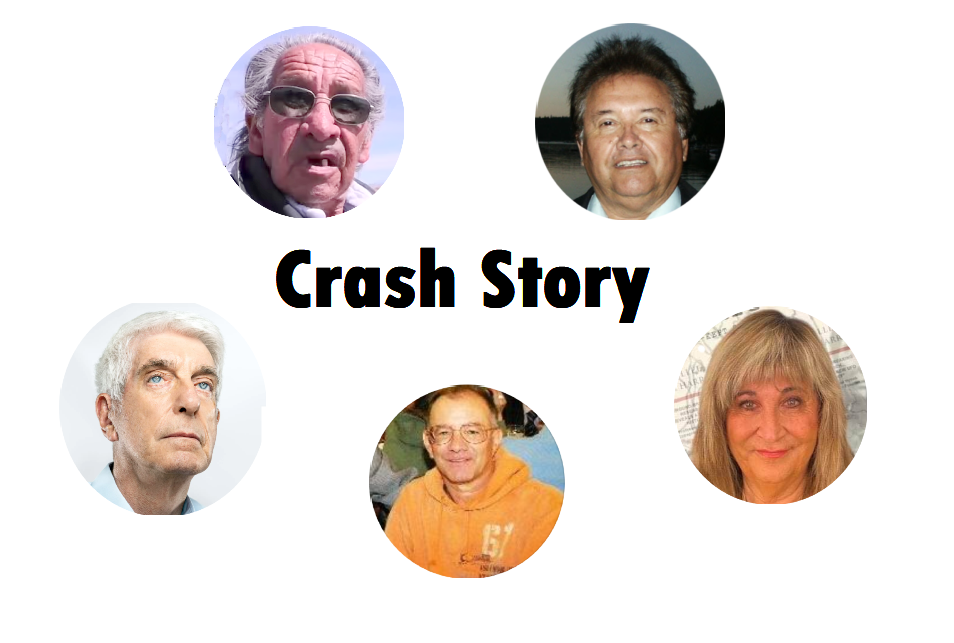
SUBSTANTIVE MODIFICATIONS OF THIS ARTICLE SINCE ITS ORIGINAL PUBLICATION ON MAY 1, 2023
(1) Added the information that the photo at the top of this article, showing a simulated crashed UFO that was part of the filming of an X-Files episode, was taken by Gareth M. Smart near his home in Ashcroft, British Columbia, Canada. Thanks to Curt Collins for this information.
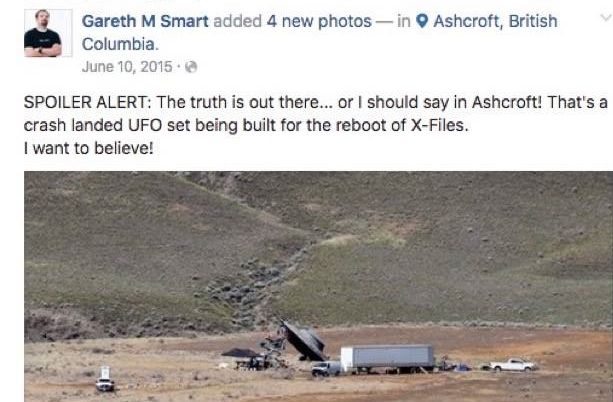
(2) May 22, 2023: I inserted information from an email in which Donald Schmitt told me that after further review of his records, he believes that his conversation with Reme Baca occurred following a summer, 1995 lecture (rather than summer, 1997). Also, I inserted references and links to my May 20, 2023 article Crash Story File: The Reme Baca Smoking-Gun Interview, which contained proof that Baca had engaged in major re-writes of his childhood-adventure story right up to its first presentation to the public in late 2003.
(3) May 23, 2023: I rearranged some of the paragraphs, added subheadings, and added a quote from a 2021 essay in which David Halperin noted that "one of these [purported Roswell] witnesses, the doubtfully reliable Gerald Anderson, told in 1990 or thereabouts a story of his encounter (as a five-year-old boy) with a crashed UFO that sounds so close to Baca’s, even in its language, that it’s hard for me to believe Baca wasn’t drawing on it." On May 29, 2023, I reformatted the Halperin quote to make the attributions clearer.